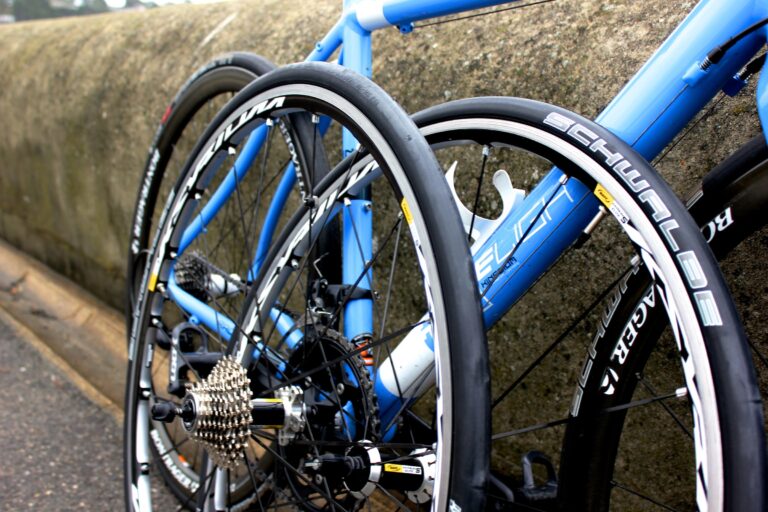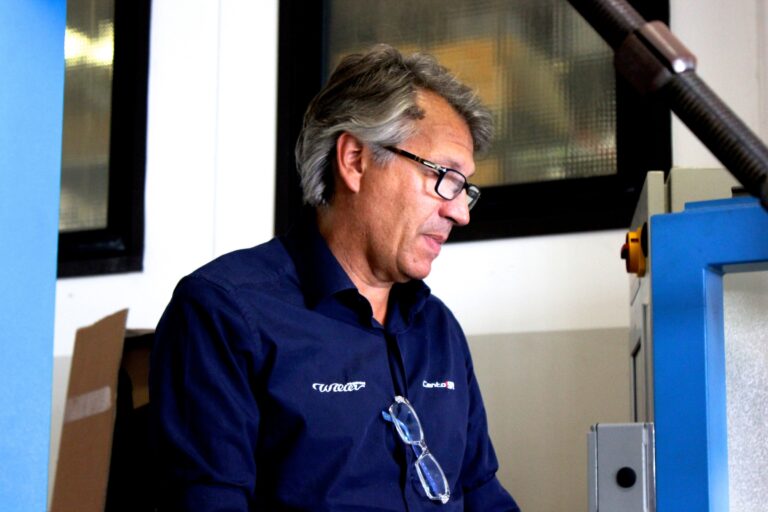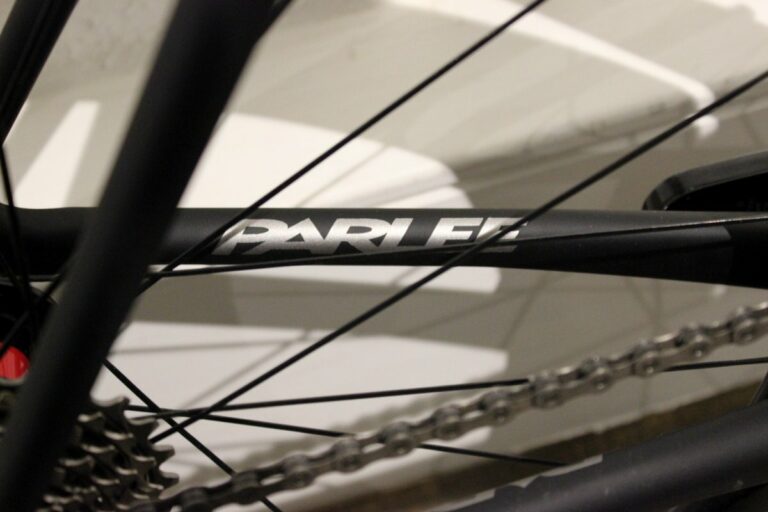It’s still warm in Sicily in mid October, and the slow, early evening withdrawal of the sun’s rays from the lower slopes of Mount Etna envelopes a small function room in a hotel in Zafferana in a cooling semi-darkness.
The room contains a table on which rests one of the most discussed and eagerly anticipated road bike components for decades. In front of the table, sits one of two men responsible for bringing it from high-level concept to reality over a period of about six years; a process that has included strapping diving weights to his body and cycling down some of the world’s steepest mountain passes.
A hydraulic disc brake for road bikes is not the first ‘game changing’ development that Tim Gerrits, a former aircraft engineer, has driven to market for Shimano, the Japanese component giant headquartered in Osaka. Programmable, electronic gear shifting in the manufacturer’s flagship Dura-Ace groupset, and the E-Tube connection system that underpins it, are among his other significant achievements.

With the fervour surrounding hydraulic disc brakes for road bikes unquenched by the appearance last year of a system from Formula for Colnago’s legendary C59 race bike, or by SRAM’s unveiling of its Red 22 and S-700 units in April, and with Campagnolo, the venerable Italian firm for whom form holds parity with function, yet to take an interest in disc brakes, it has fallen to Shimano, by far the biggest player in cycle component manufacture, to complete the picture.
“That’s a Shimano philosophy,” Gerrits tells RoadCyclingUK in a revealing interview. “If we bring something, it should be better, something extra, something to add value to the market, and not, ‘Everyone wants disc brakes, so let’s make a disc brake’
Gerrits joined Shimano 16 years ago, a newly qualified aircraft engineer entering a suddenly desolate employment market for Dutch aviation. Coincidentally, the cycle industry was suddenly awash with aerospace technologies: carbon fibre was new on the scene, and the use of high-end aluminiums becoming common place.
The Shimano philosophy is that if we bring something, it should be better, something extra, something to add value to the market, and not, ‘Everyone wants disc brakes, so let’s make a disc brake.’- Tim Gerrits
Geritts, a keen mountain biker filling time by working as a mechanic in a friend’s bicycle shop, took a commercial role with Shimano, but soon found himself moved to a technical position, becoming firstly a troubleshooter for Shimano’s biggest clients – the bike manufacturers or ‘OEMs’ – before taking responsibility for wheels, pedals and shoes. A reorganisation at Shimano Europe has placed him in a “full on product team” with a staff of just three, headed by former elite level mountain biker, Bas Van Doren.
Working now as product coordinator, Gerrits’ role is to balance the demands for new product from Shimano’s European sales force with its technical department in Japan. “On one hand you have the sales team pushing: ‘We we need this now, this year, otherwise we lose the market,’” says Gerrits. “Then there is the Japanese development team saying, ‘We’re not ready. We only bring it out when we are ready and when we are confident it’s going to bring that added value.’” Managing that tension is only part of his role, however. Gerrits and his colleagues shape the genesis of a product, deciding whether its development should be short, medium or long term.
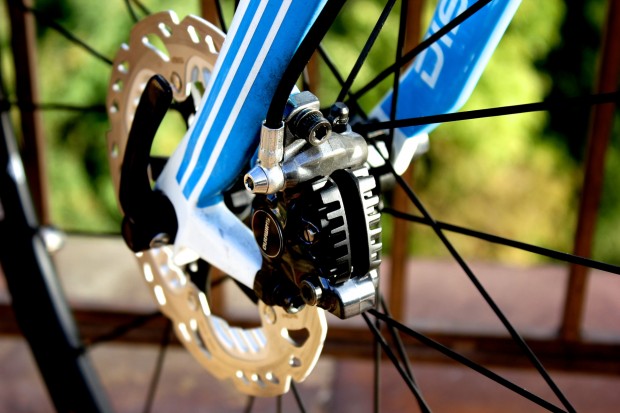
The idea of hydraulic disc brakes for road bikes has divided opinion since it was first mooted. In Shimano’s case, Gerrits reveals, that was five or six years ago when high-level concepts were first discussed. The conclusion reached at that time was that the market wasn’t ready, and the resistance to the idea voiced variously in internet forums and in the minutes of meetings from the UCI’s Sport and Technical Committee suggests that a significant number still aren’t. But Gerrits and his colleagues have forged ahead, offering the consumer a product denied to professional riders; an irony not lost on Shimano, whose advertising campaign for the R785 features four riders from the elite WorldTour staring wistfully through a shop window at the longed-for discs.
I think disc brakes are the future. We need evolution in the frames, in the wheels, and in the components in the next couple of years to see that happen
Gerrits does not accept that the tail is wagging the dog; that disc brakes have been developed largely in response to the unsuitability of pro level equipment for amateur riders, notably full carbon clincher wheelsets, a product, he points out, that Shimano refuses, on safety grounds, to manufacture. Instead, he finds a precedent in Shimano’s introduction of 29er mountain bike wheels below the race-specific XTR level, and draws a parallel with the introduction of disc brakes to mountain bikes, a process then considered heretical by those who put their faith in V-brakes. Gerrits looks puzzled at the memory. “V brakes were good enough for some people, but it was not the best thing for everyone. It was a slow evolution, until it reached a critical point.” He argues that the debate surrounding hydraulic disc brakes for road bikes has reached a similar point, and, crucially, that a similar process of evolution, and co-operation between manufacturers of frames, forks and wheels, will be required to make discs the standard for tarmac as well as trail.
BMC has been an early adopter, even manufacturing its own carbon rimmed, disc-specific wheel. A fleet of the Swiss manufacturer’s Granfondo GF02 machines has been brought to Sicily to Shimano’s international press camp to launch the R785. Gerrits argues that the brand’s market position – high-end machines for customers with high disposable income; what he describes as ‘tourist’ cyclists – makes hydraulic disc brakes an essential proposition for the Swiss brand. When RCUK spoke to BMC’s head of development, Stefan Christ, at Eurobike, we were told that “rim braking is something from the past; something we should get rid of as soon as possible.” Does Gerrits share this view? “I think disc brakes are the future,” he says, before adding that Shimano also makes high quality rim brakes. “If that’s going to be three years, five, years, or 10 years, I don’t know. We need evolution in the frames, in the wheels, and in the components in the next couple of years to see that happen.”

The interdependent nature of developing a hydraulic disc brake system for road bikes, and the need for a joint approach among manufacturers from across the bicycle industry is clearly not lost on Gerrits, even if it has been in some of the fervour that has surrounded the issue; one that at its simplest can be characterised as ‘mountain bikes have disc brakes; why not road?’ Gerrits is familiar with the technical challenges created by shoe-horning a disc rotor and a 10 or 11-speed cassette into the 135mm void between dropouts. He calmly lists the likely solutions (wider crank platforms to preserve shorter chainstays, or a longer chainline with narrower Q-Factor). “That might be one area where we have to find a sweetspot and a compromise,” he says. “There’s not just one perfect solution. The OEMs and bike manufacturers are just starting to see that.” Shimano, you get the impression, have been here before.
“It is important that we work together, and we do that on a really high level with the bike manufacturers,” he continues. “You’ve seen that in just one year, the market has opened for disc brakes. You cannot expect that all bikes are perfect next season. That will take some time.”
It’s to Shimano’s credit – and Gerrits’ – that they are under no illusion that the R785 is the first step on a very long road. This opening offering for road bikes is based heavily on the technology used in their mountain bike systems, but Gerrits foresees that with co-operation from bike manufacturers, solutions tailored to road bikes will evolve. He places smaller rotors at the centre of this predicted evolution; a development, he says, that will offer greater modulation, and which has been placed within Shimano’s reach by a ‘sandwich’ construction that Shimano calls IceTech. Earlier in the day, he showed the assembled journalists a 140mm rotor, and expressed his disappointment that no bike manufacturer had developed a compatible fork mount for the caliper that would allow its use at the press camp. Later, during this interview, he adds that with 140mm rotors “it starts to look like a road bike”. Power is a side issue, he maintains; control and consistency are its key advantages. The size of the contact patch (typically no more than 28c) means a rim brake already has sufficient power to lock a wheel; an undesired circumstance. “We’re not there to make more brake power,” he clarifies, “but a very consistent, strong feel.”

Earlier in the day, Andy Schleck arrived at the press camp and was an unexpectedly vocal presence at Gerrits’ seminar. There is little doubt that the two-time Tour de France runner up (and 2010 ‘winner’ after Alberto Contador was stripped of the title) is a supporter of disc brakes and would like to see their use allowed in the WorldTour peloton. Gerrits is more measured. The R785 is a suitable product for gran fondo riding, he says, but concedes that the system is not yet of a standard to be raced. Younger pros are supportive, he continues, but he is aware of differences in attitude across the generations from his experience training WorldTour mechanics. “They would rather replace a chunk of metal than update firmware,” he says of the resistance of some to programmable electronic shifting. He has already encountered disquiet among mechanics for the need to service – and change – separate wheels that use of disc brakes in the peloton would demand. “There is still someway to go,” he concedes.
Professional riders have been involved in the development of the R785, notably riders from the cyclo-cross teams of Rabobank, FDJ and BKCP, and the retired former Orica-GreenEDGE rider, Lars Teutenberg. Gerrits points at his chest and laughs when asked if any ‘ordinary’ riders had been involved in the testing. Earlier in the day, his presentation had included slides of him wearing body armour at the behest of his Japanese employers for the earliest tests. By the latter phases of development, with Shimano now convinced of the disc brake’s safety, he had swapped body armour for a weighted diving belt, boosting his mass to 130kg for descents from some of the highest and steepest mountain passes in Europe.
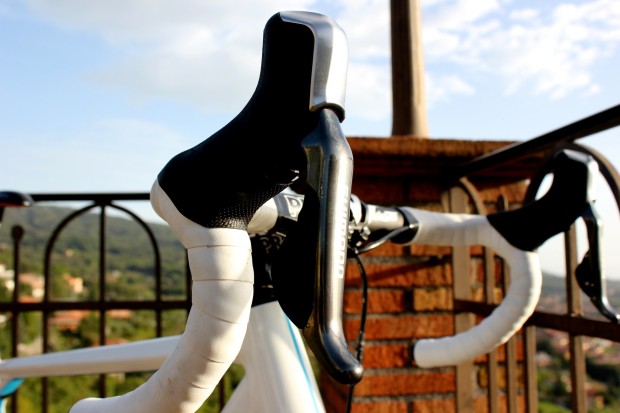
Of the ‘big three’ component manufacturers, SRAM was the first to market with a hydraulic disc brake. The American firm’s mechanical-only approach to shifting means that its hydraulic disc brake can be used with conventional, cable-operated gears. Shimano, whose Di2 electronic gear shift was the first of the ‘big three’ to see the light of day, has followed a different path. For now. Will we see the Japanese giant roll out hydraulic disc brakes with dual control levers for mechanical shifting? This is a difficult question to answer, he says. Shimano’s hope is that they will. Mathematics dictates that a mechanical system would reach a wider audience, but he is adamant that performance will dictate development, rather than commercial concerns. “We’re not going to add a reservoir and have a huge slopey lever, just to have hydraulics,” he says. “That’s not going to happen. With Shimano, it will have to be at least better.”
I hope to see in the next couple of years that every serious rider will ride electric components only, regardless of the bike, style, or level
There can be few better sources than Gerrits to ask about the future of the bicycle, and which of the multitude of trends will stick and become standard equipment in the years ahead. Wider tyres, a plethora of bottom bracket standards, tubeless tyres, ever increasing gear ratios – all are part of current development. Gerrits nails his colours to the mast of electronic gear shifting, a standard he believes has “huge potential across all our groupsets”. The statement could be hugely significant. Shimano has yet to unveil an electronic groupset for mountain bikes, and has done so only at the top two tiers of its road equipment (the non-series R785 hydraulic STI lever is engineered to ‘Ultegra level’ and paired for demonstration purposes with Ultegra 6800 mechs). “For me, I hope to see in the next couple of years that every serious rider will ride electric components only, regardless of the bike, style, or level.”
For now, the R785 hydraulic road disc brake commands his attention. He is proud of the product, but keenly aware of the need to develop it, and of the role others must play if disc braking is to become the standard for road cyclists. “I think we’ve shown a super nice system for gran fondo riding, but if we want to bring it to the next level, then it’s not just the brake itself, it’s the interface, the bike, the frame – everything needs to be specially designed,” he says, “and not adopted, because what we did now, and the bike makers and component makers, they’re adapting mountain bike parts, and not developing dedicated new systems for road.” Specific development for road bikes, he concludes, will be the “game changer”.

